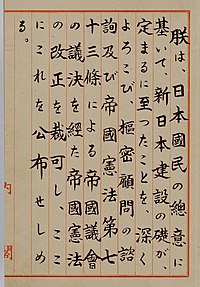Constitution of Japan

Okay, let's start with what a constitution means. A constitution is like a rulebook that tells the government what they can and cannot do. It's kind of like the rules that parents give their kids to follow at home.
Now, Japan's constitution was made in 1947 after World War II ended. Japan's government had lost the war, and the Allies who won the war helped Japan create a new constitution. This was done to make sure that Japan would never again become too powerful and aggressive.
The Japanese constitution has three important parts that explain how their government works. They are:
1. The Emperor: The Japanese believe that their Emperor is a symbol of their unity and culture, as well as their history. However, the Emperor does not really have any power to rule the country.
2. The Diet: This is like the Japanese Parliament. It has two houses - the House of Representatives and the House of Councillors. Members are elected by the Japanese people, and they are responsible for making laws.
3. The Judiciary: The Judiciary is made up of judges and courts, and they are responsible for making sure that everyone follows the law.
One more thing to remember, the Japanese constitution also has a very important article called Article 9. This article says that Japan cannot declare war or have any military forces. This means that Japan cannot attack other countries or be attacked by other countries, and they have to use peaceful means to solve any disputes.
In summary, the Japanese constitution is like a rule book for the government, and it explains how the Emperor, the Diet, and the Judiciary work together to govern the country. It also has an important article called Article 9 that promotes peace and non-violence.
Now, Japan's constitution was made in 1947 after World War II ended. Japan's government had lost the war, and the Allies who won the war helped Japan create a new constitution. This was done to make sure that Japan would never again become too powerful and aggressive.
The Japanese constitution has three important parts that explain how their government works. They are:
1. The Emperor: The Japanese believe that their Emperor is a symbol of their unity and culture, as well as their history. However, the Emperor does not really have any power to rule the country.
2. The Diet: This is like the Japanese Parliament. It has two houses - the House of Representatives and the House of Councillors. Members are elected by the Japanese people, and they are responsible for making laws.
3. The Judiciary: The Judiciary is made up of judges and courts, and they are responsible for making sure that everyone follows the law.
One more thing to remember, the Japanese constitution also has a very important article called Article 9. This article says that Japan cannot declare war or have any military forces. This means that Japan cannot attack other countries or be attacked by other countries, and they have to use peaceful means to solve any disputes.
In summary, the Japanese constitution is like a rule book for the government, and it explains how the Emperor, the Diet, and the Judiciary work together to govern the country. It also has an important article called Article 9 that promotes peace and non-violence.
Related topics others have asked about:
Article 96 of the Japanese Constitution,
Article 9 of the Japanese Constitution,
Basic Law for the Federal Republic of Germany,
Constitution Memorial Day,
Constitution of Italy,
History of Japan,
Meiji Constitution,
Politics of Japan,
Proposed Japanese constitutional referendum,
Seventeen-article constitution
